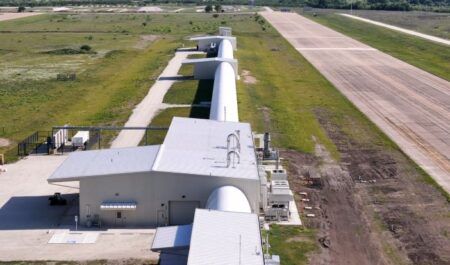Researchers in the USA have recreated midair collisions between small drones and large aircraft to asess the extent of the possible damage to the large aircraft.
In a test designed to mimic a midair collision at 238mph (383km/h), researchers in from the University of Dayton Research Institute (URDI’s) Impact Physics group launched a 2.1 lb (1kg) DJI Phantom 2 quadcopter at the wing of a Mooney M20 aircraft. The drone did not shatter on impact, but tore open the leading edge of the wing as it bore into the structure, damaging its main spar.
“While the quadcopter broke apart, its energy and mass hung together to create significant damage to the wing,” said Kevin Poormon, group leader for impact physics at UDRI.
Poormon’s research group routinely performs sponsored bird-strike testing of aircraft structures, such as wings, windscreens and engines and has fired individual drone batteries, cameras and motors at metal panels to produce data about UAV and aircraft collisions.
The results of the wing tests were presented the test results and video of the drone shot at the recent Unmanned Systems Academic Summit at Sinclair College’s National UAS Training and Certification Center in Dayton, Ohio.
As the number of hobby drones in the air dramatically increases, so does the risk of a catastrophic event, Poormon said.
“We’ve performed bird-strike testing for 40 years, and we’ve seen the kind of damage birds can do. Drones are similar in weight to some birds, and so we’ve watched with growing concern as reports of near collisions have increased, and even more so after the collision last year between an Army Blackhawk helicopter and a hobby drone that the operator flew beyond his line of site.”
Although the helicopter returned home with only minor damage to a rotor, Poormon believes it is only a matter of time before a drone strike causes more significant damage to a manned aircraft.
“We want to help the aviation community and the drone industry understand the dangers that even recreational drones can pose to manned aircraft before a significant event occurs. But there is little to no data about the type of damage UAVs can do, and the information that is available has come only from modeling and simulations,” he said.
“We knew the only way to really study and understand the problem was to create an actual collision, and we’re fully equipped to do that.”
Calibration and testing
For the latest research on wing collisions, the group collaborated with the Sinclair College National UAS Training and Certification Center, which provided guidance on unmanned aerial systems.
“We’re fortunate to be in close proximity to Sinclair’s nationally renowned UAS Center,” Poormon said. “We’re experts on bird strikes, but the Sinclair team’s insight on how these systems are being used helped us determine the best models for testing.”
Sinclair also provided the quadcopters for the tests and loaned UDRI the aircraft wing to serve as a target.
After calibration work to ensure they could control the speed, orientation and trajectory of a drone, researchers fired a successful shot at the Mooney wing. The researchers then fired a similarly weighted gel “bird” into a different part of the wing to compare results.
“The bird did more apparent damage to the leading edge of the wing, but the Phantom penetrated deeper into the wing and damaged the main spar, which the bird did not do,” said Poormon.
He added that he is unaware of any other laboratories performing controlled drone strikes on structures for research or data generation
The researchers believe that additional tests using similar and larger drones on other aerospace structures, such as windscreens and engines, are needed to provide information about how catastrophic a collision would be. They also hope this first test result will help raise awareness amongst the manned and unmanned aviation communities about the importance of regulations related to safe drone operating.
“It’s not practical to regulate manned air vehicles to try to avoid collisions with a quickly growing population of drones, but it is practical to regulate UAV operation,” Poormon said, adding that the USA’s FAA already has a number of regulations in place for drone operators.
Other factors that could be looked at to reduce the damage-related to UAV impacts could be related to their design, such as building drones to be more frangible or keeping them under a certain weight limit, he said.
“The shipping industry is already investigating ways to use drones for package delivery. That would require larger and heavier drones which, when combined with the weight of a package, could easily outweigh a Canada goose, known to do significant damage to aircraft.”
Andrew Shepherd, executive director and chief scientist at Sinclair’s National UAS Training and Certification Center, said the emergence of unmanned aerial systems in the civil and commercial markets is projected to be a significant driver of economic activity and is already providing value across a number of industries.
“This type of testing shows that we recognized the potential risks and are seeking to better understand them and positively influence policy and operations to mitigate possible dangers,” Shepherd said.
“Collaborating with UDRI’s leading experts and world-class testing facilities helps us fulfill our mission to not only advance technologies for unmanned aerial systems, but to make the skies safer for manned and unmanned vehicles alike.”
This article was originally written by Pamela Gregg for the University of Dayton Research Institute’s Blog.




